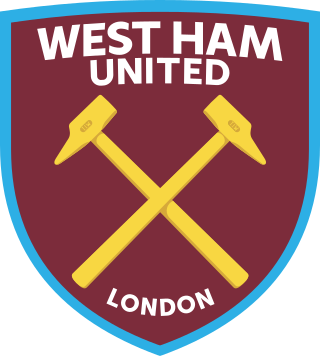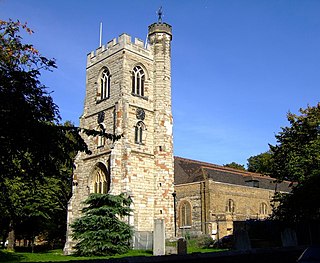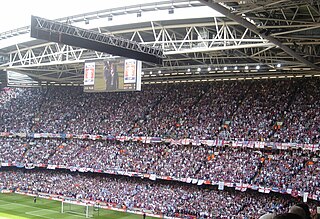
West Ham United Football Club is an English professional football club that plays its home matches in Stratford, East London. The club competes in the Premier League, the top tier of English football. The club plays at the London Stadium, having moved from their former home, the Boleyn Ground, in 2016.

Penge is a suburb of South East London, England, now in the London Borough of Bromley, 3.5 miles (5.6 km) west of Bromley, 3.7 miles (6.0 km) north east of Croydon and 7.1 miles (11.4 km) south east of Charing Cross.

West Ham is an area in East London, located 6.1 mi (9.8 km) east of Charing Cross in the west of the modern London Borough of Newham.

East Ham is a district of the London Borough of Newham, England, 8 miles (12.8 km) east of Charing Cross. Within the boundaries of the historic county of Essex, East Ham is identified in the London Plan as a Major Centre. The population is 76,186.

Bromley, commonly known as Bromley-by-Bow, is a district in the London Borough of Tower Hamlets in East London, located on the western banks of the River Lea, in the Lower Lea Valley in East London.

Poplar was a local government district in the metropolitan area of London, England. It was formed as a district of the Metropolis in 1855 and became a metropolitan borough in the County of London in 1900. It comprised Poplar, Millwall, Bromley-by-Bow and Bow as well as Old Ford, Fish Island and Cubitt Town.

Millwall Football Club is a professional football club in Bermondsey, South East London, England. They compete in the EFL Championship, the second level of English football. Founded as Millwall Rovers in 1885, the club has retained its name despite having last played in the Millwall area of the Isle of Dogs in 1910. From then until 1993, the club played at what is now called The Old Den in New Cross, before moving to its current home stadium nearby, called The Den. The traditional club crest is a rampant lion, referred to in the team's nickname The Lions. Millwall's traditional kit consists of dark blue shirts, white shorts, and blue socks.

Canning Town is a district in the London Borough of Newham, East London. The district is located to the north of the Royal Victoria Dock, and has been described as the "Child of the Victoria Docks" as the timing and nature of its urbanisation was largely due to the creation of the dock. The area was part of the ancient parish of West Ham, in the hundred of Becontree, and part of the historic county of Essex. It forms part of the London E16 postcode district.

Bow is an area of east London, England, within the London Borough of Tower Hamlets, 4.6 miles (7.4 km) east of Charing Cross.

Kingsley Hall is a community centre, in Powis Road, Bromley-by-Bow in the London Borough of Tower Hamlets. It dates back to the work of Doris and Muriel Lester, who had a nursery school in nearby Bruce Road. Their brother, Kingsley Lester, died aged 26 in 1914, leaving money for work in the local area for "educational, social and recreational" purposes, with which the Lesters bought and converted a disused chapel. The current Hall was built with a stone-laying ceremony taking place on 14 July 1927.

The Greenway is a 7-kilometre (4.3 mi) long footpath and cycleway in London, mostly in the London Borough of Newham, on the embankment containing the Joseph Bazalgette Northern Outfall Sewer.

West Wickham is an area of South East London, England, in the London Borough of Bromley. It lies south of Park Langley,Eden Park Beckenham and Bromley town center, west of Hayes and north of Coney Hall, east of Spring Park and Shirley. 10.3 miles (16.6 km) south-east of Charing Cross on the line of a Roman road, the London to Lewes Way. Before the creation of Greater London in 1965, West Wickham was in Kent.
A Francisation of traditional English "Bullen" coming from the French name Boulogne, Boleyn is the surname of a noble English family particularly prominent in the Tudor period. People with this surname include:

Muriel Lester was born in Leytonstone and grew up at Loughton, where she was a member of the Union Church. She was a social reformer, pacifist and nonconformist.

Green Street is a road in the London Borough of Newham, East London, which forms much of the boundary between East and West Ham.

London derbies are the various local football derbies between the teams in London, England. It specifically refers to individual matches between the teams, but can also be used to describe the general ongoing rivalry between the clubs and fans. The first London Football League derby took place at Clapton Stadium on 11 November 1905, where Chelsea beat Clapton Orient 3–0 in a Second Division match. Chelsea also won the first top-flight London derby with a 2–1 victory over Woolwich Arsenal, in a First Division game at Stamford Bridge on 9 November 1907. The first FA Cup Final to be contested between two teams from London was the 1967 Final, where Tottenham Hotspur beat Chelsea 2–1. As of the 2021–22 season, there are thirteen clubs in the Premier League and Football League that play in the Greater London area. Arsenal against Tottenham Hotspur and Millwall against West Ham United are ranked as two of the most ferocious London derbies.

The rivalry between Millwall and West Ham United is one of the longest-standing and most bitter in English football. The two teams, then known as Millwall Athletic and Thames Ironworks, both originated in the East End of London, and were located less than three miles apart. They first played each other in the 1899–1900 FA Cup. The match was historically known as the Dockers derby, as both sets of supporters were predominantly dockers at shipyards on the River Thames. Consequently, each set of fans worked for rival firms who were competing for the same business; this intensified the tension between the teams. In 1904, West Ham moved to the Boleyn Ground which was then part of Essex until a London boundary change in 1965. In 1910, Millwall moved across the River Thames to New Cross in South East London and the teams were no longer East London neighbours. Both sides have relocated since, but remain just under four miles apart. Millwall moved to The Den in Bermondsey in 1993 and West Ham to the London Stadium in Stratford in 2016.

The 2009 Upton Park riot occurred in and around West Ham United's Boleyn Ground, in Upton Park before, during and after a Football League Cup second round match between West Ham and Millwall on 25 August 2009. The match was won by the home side 3–1 after extra time, but the game was marred by pitch invasions and disorder in the streets outside the ground, where a Millwall supporter was stabbed. The disturbances were met with condemnation by the Football Association, the British government and the two clubs involved. The incident led to fears of a return of the hooliganism that had tarnished the reputation of English football in the 1970s and 80s. There were also concerns that it could have a negative effect on England's bid to host the 2018 World Cup - which was rejected in favour of the bid from Russia more than a year later.

West Ham United F.C. supporters are the followers of the London-based West Ham United Football Club, who were founded as Thames Ironworks in 1895. There are 700,000 fans on the club's database and over 2,300,000 likes on Facebook. The club's website is in the top ten most visited websites for English football clubs by people in the USA. Their fans are also associated with a once-notorious hooligan element and have long-standing rivalries with several other clubs, most notably Millwall.
Green Street House, usually known as Boleyn Castle, was a stately home in East Ham in the modern London Borough of Newham, East London.




















